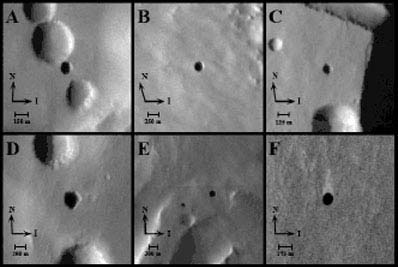There are many caves on Mars?
The application of techniques to study caves on Earth to discover the viability of caves on Mars proved very successful and is gaining some good results.
Glen Cushing and Jut Wynne are researchers at Northern Arizona University (NAU), currently working at the National Geographic Survey (US), saying: "Photographs from the ship exploding Mars "The Odyssey shows that there are many pits the size of a football field. These holes may be the entrances of the caves."
Wynne, a NAU graduate student in biology and chair of the American National Geological Survey (USGS) 's Earth and Mars Cave Search Program, said: ' If life exists on Mars, you will have a lot of chances to find it in caves. '
He added: "This discovery could lead to many exploratory programs focused on Mars. Caves on Mars are said to be" the ideal paradise for life "because they are protected against. re-radiation on the surface of Mars and other factors ".
Cushing, an assistant to NAU's Department of Physics and Astronomy, who first identified black spots on pictures, explained: 'The environment on Mars's surface is extremely extreme. Therefore, the importance of caves lies in their natural protection. The cave on Mars may become a habitat for future explorers or it may be the place where the evidence of past and present early life forms remains. '

The researchers propose that 7 black points near the massive volcanoes on Mars may be caves, not the ones created by collisions with meteorites.These photos were taken by the infrared imaging system on the Mars Odyssey ship by NASA.
Cushing and Wynne joined Tim Titus, a celestial physicist with USGS, and Phil Christensen, NASA scientist responsible for photography and a Arizona State University researcher, recently submit a study of their findings to the 38th moon and planetary science conference.
Wynne explained: 'We are hypothesizing that 7 black points are the windows on the ceiling of the areas where its surface has collapsed into a large cavity below. Evidence of past life on Mars can only be found in caves and such detection is of great importance. '
The statement about the discovery of the caves is based on an analysis of photographs taken by NASA's Mars Mars Odyssey. These photos show these 7 black spots near the giant volcano named Arsia Mons on Mars . Although this region is known as a region of geological events on Mars, the researchers still claim that these black spots are not the same as those created by collisions with meteorites because they do not have high craters or pits of explosions.
Nadine Barlow, associate professor of NAU university's department of physics and astronomy and a talk about meteorite craters, said: 'This is a very interesting finding that contains many things. pole. Caves on Mars may be good places for ice accumulation and this makes them the ideal places to search for life on Mars as well as searching for reservoirs to support them. human-made experimental program on this planet. '
The overall purpose of the planet and Mars search program is to develop techniques to systematically search for caves on earth with infrared devices and then apply techniques. This technique goes into finding caves on Mars.
The team has announced cave systems ranging in width from 100.58 meters to 251.46 meters and located at a depth of 129.54 meters. These caves are named after the members of the research team such as Dena, Chloe, Wendy, Annie, Abbey, Nikki and Jeanne.
Christensen said the first opportunity to have more detailed observations could be provided by NASA's latest Mars Mars probe, the Reconnaissance probe ship.
He said: 'This probe's high-resolution camera will have a closer look at those seven black points, including observations along these black spots where it can show whether there are characteristics. Open deep into the holes below. '
The Kiet
- Discovery of art caves near 50000 years old
- Two caves with stalactites in Quang Binh
- The village has 100 people living in caves, separate from the outside world
- Did the ocean on Mars get into the rock?
- Caves 'made in Vietnam' equally as beautiful as Son Doong cave
- NASA explains the confusing
- Top 10 photos of Mars
- The most unique crystal cave in the world
- Life may have existed 700 million years on Mars
- NASA has just taken a monstrous photo that looks like a fake about Mars
- Mars used to be 'green planet' like Earth
- Humans can stay in Mars and Moon caves
 Van Allen's belt and evidence that the Apollo 11 mission to the Moon was myth
Van Allen's belt and evidence that the Apollo 11 mission to the Moon was myth The levels of civilization in the universe (Kardashev scale)
The levels of civilization in the universe (Kardashev scale) Today Mars, the sun and the Earth are aligned
Today Mars, the sun and the Earth are aligned The Amazon owner announced a secret plan to build a space base for thousands of people
The Amazon owner announced a secret plan to build a space base for thousands of people